Expedition to Armenia 2013
All travel reports are translated electronically although minor improvements are sometimes made.
Expedition to Armenia 2013
My travel itinerary in Armenia:
- TAVUSH – Border in Bagratashen,
- LORI – Canyon Debed: (Alaverdi, Sadahart, Sanahin, Haghpat, Odzun, Akhtala, Kobayr), Vanadzor,
- TAVUSH: Dilijan (Goshavank, Hagartsin, Parz Lich),
- GEGHARKUNIK: Sevan (Lake and Sevanavank Monastery),
- YEREVAN, Around Yerevan: (Eshmiadzin, Gerghard, Garni, Khor Virap),
- VAYOTS DZOR: (Noravank, Areni cave, Yeghegnadzor, Yeghegis, Artabyunk),
- SYUNIK: Vayk, Sisian, Goris (Old Goris, Tatev), Kapan, Kajaran, Meghri, Agarak (border with Iran).
Bagratashen
The border on the river bridge over the river Debed is small, pleasant and hassle-free. I only showed a passport and without question I was in Armenia.
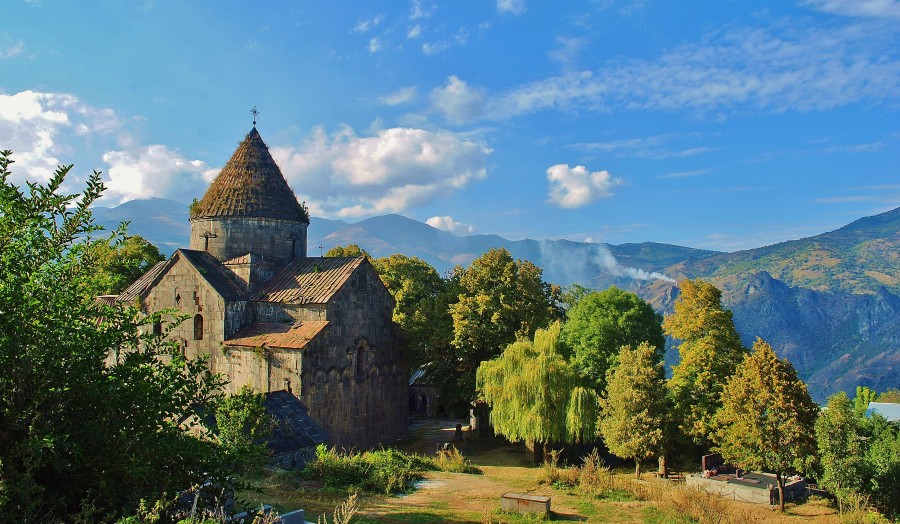
Sanahin Church. Alaverdi, Armenia.
Lori Region – (Debed Canyon)
Transportation from the border of Alaverdi
On the border was a mall for 2000 drama a place but I did not use this option. Instead, I paid 2000 for a private car. The driver first drove me to the Alaverdi pub and then to the hotel. The ride was also very pleasant as a taxi driver who told me jokes and recommended local brothels, but on the other hand also said that poverty here so that I do not think so. His car as local conditions was not bad because he was only 20 years old. We drove along the Debed Canyon and had nice views of the mountains and the river.
Alaverdi
Alaverdi is a small mining town where life does not spoil anyone. It is visible on the faces of people and on the poor streets but for the tourist it is still very pleasant and attractive tourist place. Alaverdi lies in the charming Debed Canyon, is cut by a river, has a cable car up the mountain and is also a base for several beautiful ancient monastries. I stayed here in a hostel for $ 5000 for a bed just outside the city where I usually hitchhiked. At lunch I went to the only decent pub called Flora although I usually bought fruit on the street.
By the way, the Flora restaurant is highly recommended as it serves very good grilled skewers and kebabs for little money. Transportation in Alaverdi exists but the hitch is obviously better and more adventurous. In Alaverdi itself there is nothing special to do except the cable car ride up the mountain which also gives the view of the village from above. Besides, I have organized many trips here.The people in Alaverdi are friendly.
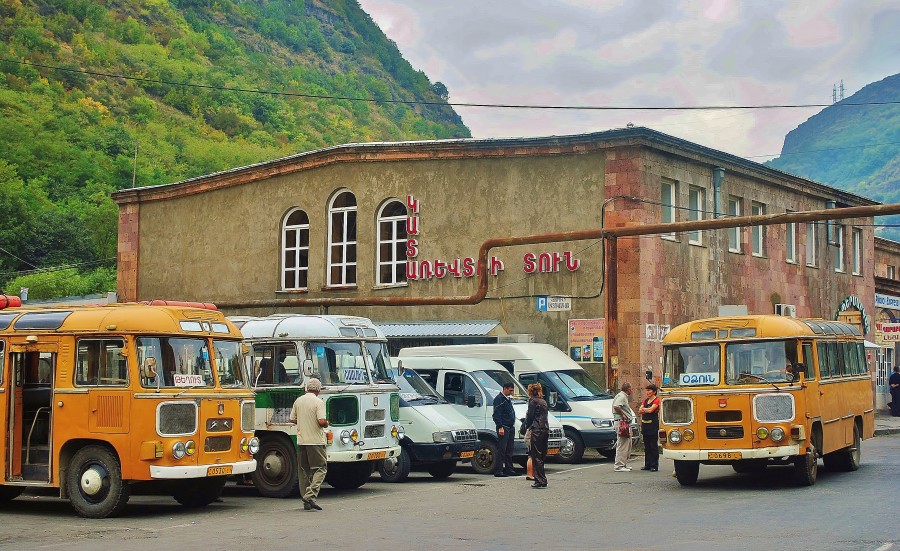
Alaverdi town. Armenia.
Sanahin
Sanahin is the 10th ancient Armenian monastery on a hill near Alaverdi. It is a very atmospheric object with thick carved walls and pillars and a moss-covered roof. Sanahin also has many huts, or carved crosses in rectangular rocks. Nearby there is also a cemetery on which I climbed and saw the monastery in all its splendor. Sanahin means “this is older than that” which refers to the neighboring Haghpat. Dark chapels, antique library, cracked stone walls with carved hooks combined with streaks of light coming through small windows give a very special feel to this place. Monastera Sanahin was my first in Armenia and probably was a special experience.
Here is also a souvenir shop where I have been a couple of times to buy some things and to have some tea.The girl who worked there complained that she made only $ 100 a month. The Alaverdi people have a lot of beautiful views and poor pennies. The gift shop was notable.
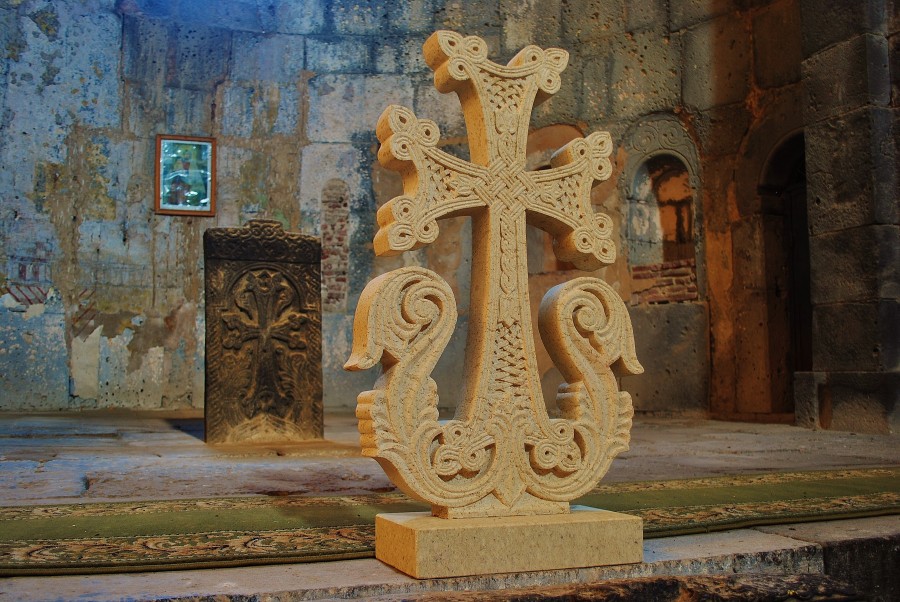
Cross inside the Sanahin Church. Armenia.
Sadahart
Tall Sadahart is located on the map only because in this small, unattractive town of concrete slabs there is a cable car station from Alaverdi. Sadahart is also about an hour away from Sanahin (1km), so everyone will surely be able to enjoy the post-Soviet life of the famously unemployed and see some wrecks of trucks.People are nice and accommodating to tourists.
The road from Sanahin to Haghpat
Debed Canyon offers magnificent views, antique monuments that are a UNESCO World Heritage Site and of course mountain trekking. One such tour which I highly recommend is about 3h, 7km walk from Sanahin monastery to Haghpat monastery. First I went about 15 minutes but soon after I hitched a hitch into Akner village. The road led me through a very hollow road during which I admired the wrecks on the slope of the route and spoke with the director of rather imperfect life in Armenia. From the village of Akner I walked about an hour through the mountains and it was very pleasant. I also had to cross the river and the Germans took me to the top of the last mountain.
Haghpat
Haghpat is another magnificent monastery that began in the 10th century and was completed in the 12th when a beautiful tower, library and chapel were built. All the objects are made of stone and have hooks engraved on the walls and on the rocks. In addition, various chapels and churches stand on different levels and are of varying heights and additionally are partially covered with green hills. When I was here Haghpat was overwhelmed by mist which gave even better effect. I also recommend to go to church, see the altar and light candles. Haghpat gives a great impression to every traveler.
By the way, I will mention here that I met a traveler from Germany with whom I traveled for some time and with whom I got on very well in terms of politics. It’s nice to meet someone like that.
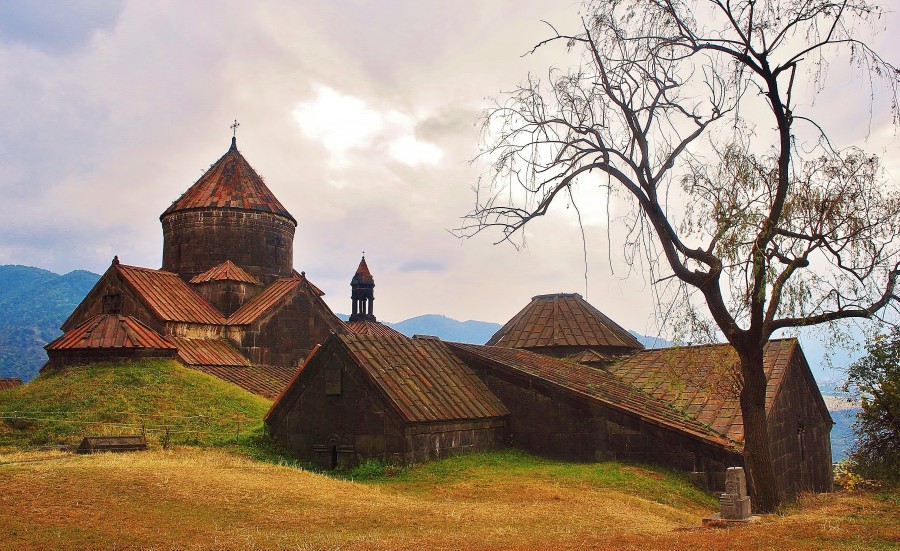
Beautiful, atmospheric Haghpat Church, near the city of Alaverdi. Armenia.
To Alaverdi I returned by the last bus.
Odzun
There is a small town of the same name on the plateau with a population of about 6000 people, with postcommunist blocks from the plate and some impressive truck wreckage. In this small seclusion of the Debed Canyon, there is also a monastery called the Badge which began in the VIth century and expanded in the 8th century. This church is in dark orange color, it has nice arches, the main broad tower and the smaller and thinner at the back, and the impressive sculpted main entrance. When I was here was a repair but anyway it was a very interesting place.
There are regular buses from Alaverdi and so I got here too. The ride was very pleasant as I watched the Debed Canyon from various levels and after leaving the bus he also stood on the edge of the cliff to have a better view of the countryside. The bus ride lasted about 20 minutes and I paid 200 dram. Back, I hitched the hitch directly to the center of Alaverdi.
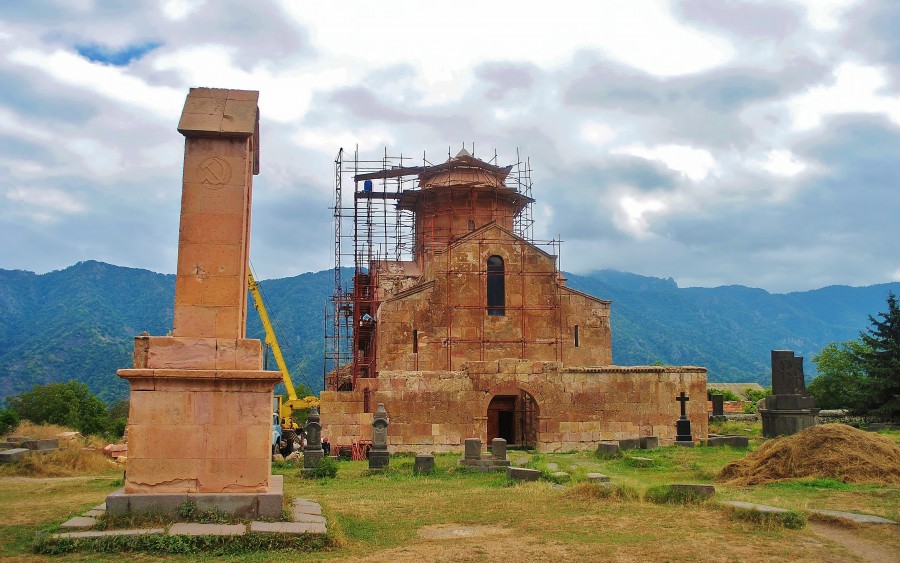
Odzun monastery. Lori, Armenia.
Akhtala
Akhtala is a beautifully located 13th-century monastery near the cliff and the walls are built in such a way that they create an extension of the cliff. Besides, the entrance and the walls look like fortresses, which makes it a good name for a monumental fortification. The architecture and art in the building are worth a visit here and deeper exploration. Akhtala is made up of several objects and is famous for its sculptures and frescoes inside. This monastery has interesting stone arches, massive pillars and colorful altar and mentioned frescoes of saints. Akhtala with its beauty is certainly not giving way to Sanahin and Haghpat, and because of its location on the cliff and frescoes is for these two reasons more effective.
Transport to Akhtala monastery
Transportation to Akhtali is an adventure. On the one hand there are 30 or maybe even 40 year old buses from Alaverdi which require patience and on the other hand there are taxis which for an 18km trip they want 2000 to 4000 drams, depending on the bargain. But my journey was much more interesting. I was hit by the owner of a 30-year-old Uaza who lived behind Akhtala and said he could bring me up close. At first, however, we went to the store to pick up the shopping and then we drove back from the hill in the meantime straining Uaza for a short time. Uaz was already in such a fatal state that he barely drove and the driver did not have the keys because he was always pulling cables. I had to keep the door on my side and the windows fell on the big holes in the road. The views of the mountains and the river were beautiful and after about half an hour the driver dropped me off the mountain where I had to climb to get to Akhtali. After a short walk I reached the town first and then (unlikely) I got on the bus going from Alaverdi and met a German from the previous monastery.
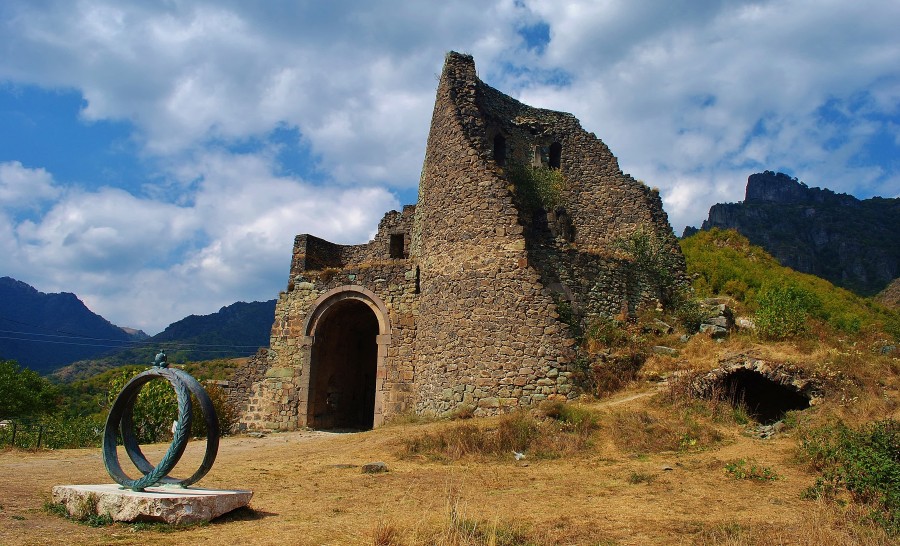
Akhtala Church from the 10th century. Lori, Armenia.
The return journey was also good. The German complained that no one helped him because no one understood him. So I stopped hitchhiking and together we came back to Alaverdi and a German traveler was charmed by Polish operability.
The road to Dalila (by the monastery Kobayr and the town of Vanadzor)
I stood for a while at a bus stop in Alaverdi but soon came to me that I could wait forever. So I stopped hitchhiking in which the cop went and soon afterwards blew me off on the road near the Kobayr monastery.
Kobayr is a monastery hidden behind the trees to climb so you should go slowly to avoid miss the mark.After a 10-minute walk up the hill, I reached the ruined church consisting of two chapels and saw the workers working hard for their restoration. One of them showed me the pictures before taking the work and actually the object is getting the right shape. The Kobayr Monastery was built in the 12th century and although it is still destroyed, you can admire the frescoes depicting Jesus and the 12 apostles, as well as the Georgian inscriptions. Besides climbing up the road is an intriguing experience. The tourist should also follow the church on the left to see the valley and a large grotto in the rocks. Going down the hosts gave me some grapes.
When I got back from Kobayr for the next hitch I waited about 30 minutes until finally stopped a very good, comfortable car and took me 40km to the town of Vanadzor. As always it was a pleasant trip through the canyon during which there were nice views.
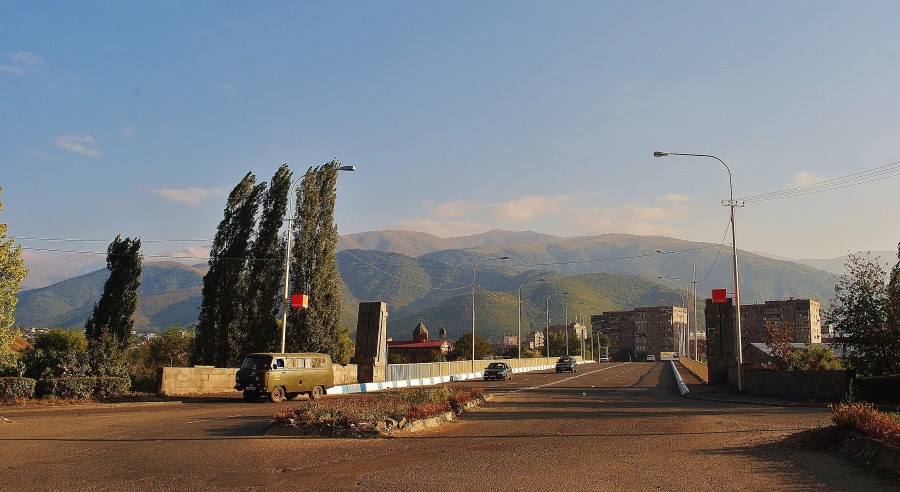
Armenia is a great adventure.
Vanadzor is a gray post-Soviet industrial city and administrative center of the Lori region. There is, of course, a church on the Pambak River, but there are also plate houses and several shops. The guide advises that Vanadzior is a good base for the Debed Canyon but in my opinion it is absurd. I passed all of Vanadzor in an hour and I had enough. Besides, Vnadzor is too far away to be a good base for previously described churches so in my opinion it does not make sense to stay here. Unfortunately, I was waiting for a hitch. I went with a large backpack along the way to stop someone but everyone wanted money on what I could not agree with because I was too poor.
When someone finally stopped, it was another unforgettable adventure. This time brought me the guy who was the most faithful of his life was clearly behind him and told me also not to fasten the belt because he “fuck the police”. Unfortunately, we stopped at the vulcanisation point first, and it lasted so long that I helped with boredom on the neighboring site. Not only did I help break the concrete stairs with a big hammer because several passersby also tried. Then in a nice but because of the overflow of risky transport after dark I came to Dilidjan.
Tavush region
Dilijan
My trip to Dilijan was very interesting and I was glad that it was finally over. Due to the numerous spots on the way to the place I reached dopiro late in the evening after dark. After tea in the local pub I had already forgotten looking for a hotel, so I spread the tent in the park near the monument of bears. But it was a cold, rainy and windy night, so I slept poorly. In the morning I had to look very poor but with cold hands I folded the tent and then changed into warm things. Then I went upstairs to the Nina hostel where I paid 4000 dram a night though it was supposed to be 7000.
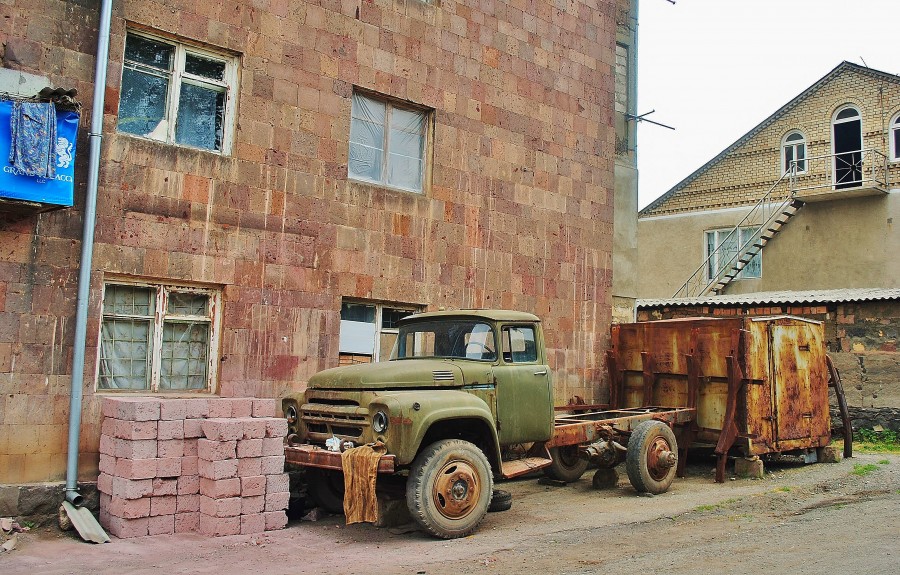
In Armenia I really liked the trucks. Here, the life of a car does not begin until it’s at least 20 years old.
I will never forget a certain breakfast in this nice house during which I met a couple of Jews. They were trying to convince me that “Jerusalem is the center of the world because when I go there I will definitely notice the specific gravity of this city.” I told him it was a Zionist fairy tale that could feed on his silly Jews but not me. Then the circumcised monsters got up from the table and left with disgust.
Dilijan is sometimes called Switzerland of Armenia and although the mountainous views are very nice it definitely is not Switzerland. The town itself is very charming because the center is located in the pond and there is also a park near and several restaurants. Unfortunately, and here is pro Soviet propaganda because the roundabout at the entrance stands an ugly memorial 50 years of Soviet Armenia . On the other side of the pond is a road leading to areas not located on postcards. Going through the ruined road and the scrub on the left side I saw the ball court and the right gray blocks with plates hanging laundry. But there was something I never wanted to see in Poland. It was a huge monument depicting the “heroic” soldier of the Red Army holding a dying companion. Below was a dry fountain with a red star and the entire communist circus was named Monument to the Second World War .
The Dilidan consists of two parts, the lower one and the one on the top. Upstairs there is a very interesting Art Gallery and the historic center of Dilidan in the form of well-maintained houses, shops and restaurants built of stone and wood. The upper part is much larger than the small center at the bottom.
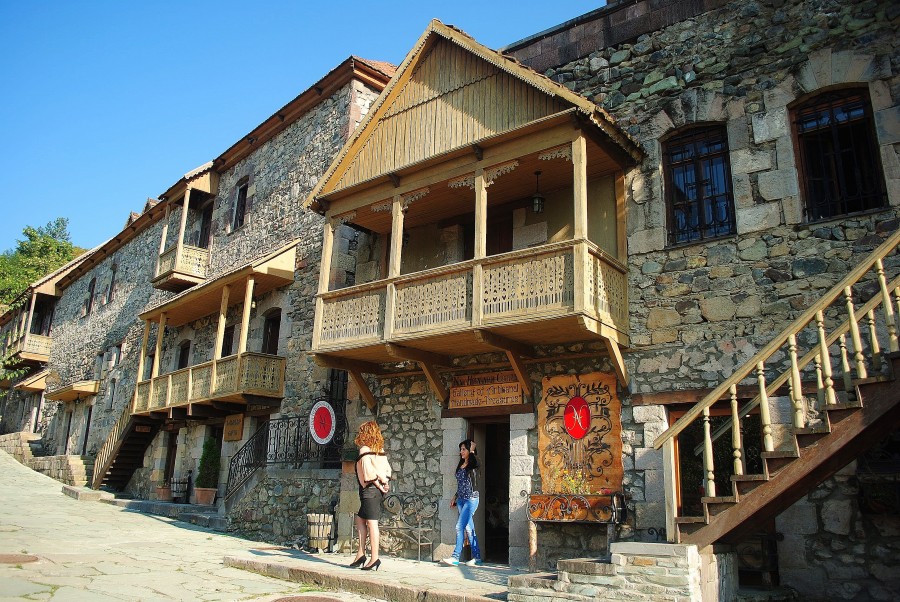
Gift shop in Dilidjan. Armenia.
Dilijan is also a very good base for some wonderful monasteries: Goshavank and Hagartsin.
Goshavank
Goshavank is a monastery built in 1188, which lies on a hill near the village of Gosh. This is another beautiful Christian building of Armenia built entirely of stone. The whole consists of a main church and two smaller ones as well as a school and a library. Inside there are massive pillars, a pretty altar, candles to light up and silent silence and the effect of shining light through a small stone window. Outside there are also some hacks (crosses carved in rectangular rocks). According to historians, Goshavank once owned a collection of 15,000 books that were burned by Timur’s army in the thirteenth century. The monastery is also surrounded by a hotel, a restaurant, a souvenir stand and people living in their bungalows on a hill.
From Dilijan, I took a hitch and then from the turn at Hagartsin the next hitchhiking for about 5km.
Parz Lich
After Goshavank I went to Parz Lich, which is a small and located in a pleasant holiday area. The whole of Parz Lich’s charm is its green lake surrounded by mountains and forests and beautiful silence. There are families here for fishing and barbecue and it is a unique pleasant and peaceful place.
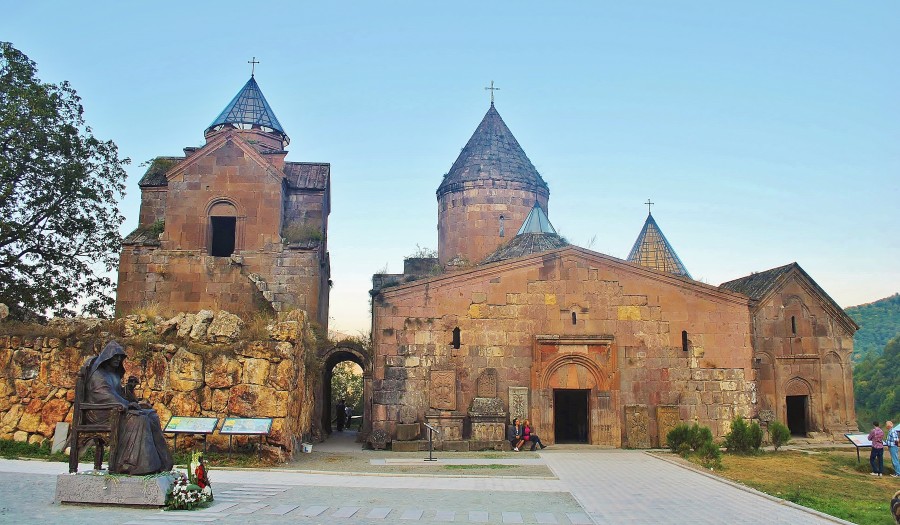
Goshavank church from the 12th century, situated in a picturesque setting. Tavush Province, Armenia.
Parz Lich is located a few kilometers from the main road from Goshavank towards the Dilidjan. Then from the turn is still 10km which I drove another hitch in two directions.
Hagartsin
Hagartsin is a monastery of the twelfth century consisting of two churches and a small chapel. This monastery, just like the former, is built of stone and lies in a picturesque valley underneath the walnut trees. In the churches there are also some beautiful hooks, interesting stone arches and a sculpted image of Mary and Jesus over the entrance door.
Just like the previous monasteries Hagartsin is also beautiful and hot recommend it.
To Hagartsin I got two hubs from Dilijan. First off the main route to turn to the monastery and then 4km further through a secluded, wooded area cut by the river. Here I went about 2km until finally someone picked me up.
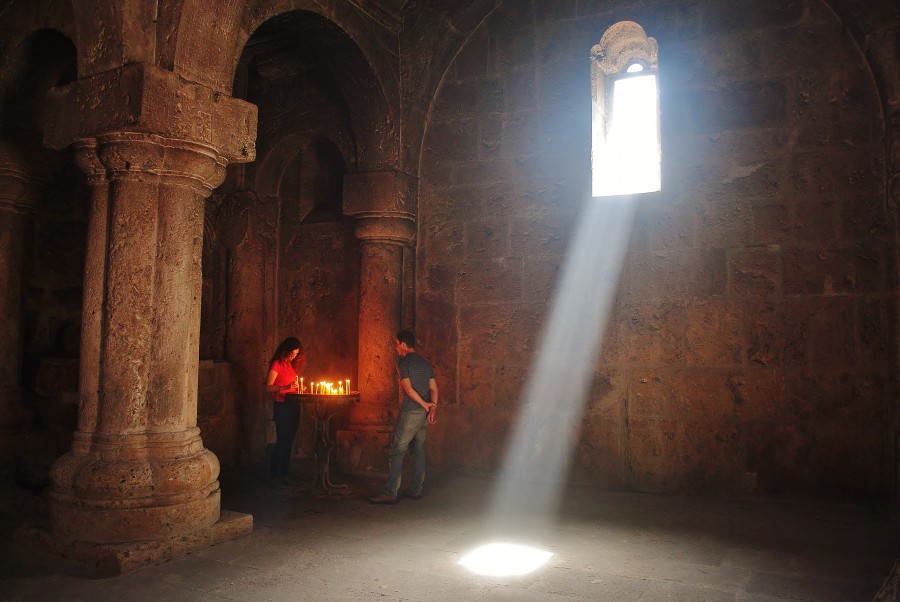
Athmospheric interior in the stone church of Haghartsin. Armenia.
Transportation from Dilidjan to Sevan
The trip from Dilidjan to Yerevan and to Sevan costs 1000 dramas, but I did not want to pay on the one hand, and on the other I wanted to experience another adventure in transport. So I walked out of the town and after about a 10 minute walk uphill with my big backpack I stood on the road. I admit that I was not happy for a long time, but finally one of the better hitches of my life came up. It was a 40-year-old red-eyed Ziguli who kept sticking out only because of the viscous paint and then rushing into the rhythm of Russian music, he drove south of Armenia and threw me off at Lake Sevan. It was a great transport. To start with, I left my backpack in the motel so I could tour.
Gegharkunik region
Sevan Lake and Sevanavank monastery
Sevan Lake is the largest in Armenia and throughout the Caucasus and is also one of the largest high freshwater lakes in the world. Because of its close proximity to Erywana, summer is a holiday resort. There are several hotels, restaurants and several souvenir stands here. In the summer season, Lake Sevan attracts several trout fishermen, but first of all it is visited due to the Sevanavank monastery. This monastery was originally built on the island but the drop in water level caused it to be located on the peninsul. Sevanavank was built in the 9th century, it is located on the top of the mountain and consists of two churches: Surp Arakelots and Surp Astvatsatsin. They are very similar to each other, built of stone and covered with red roofs. In addition there are hacks, nice altars in the middle and beautifully carved entrance doors to Surp Arakelots.
In Armenia, there are many beautiful Christian monasteries and this one adds to that it offers beautiful views of the lake and the entire unspoiled civilization. Being here (provided there are no crowds) you can rest well. After going down I took a bath in the icy water and raised a lot of interest because I was the only one who took it. At the bottom of the residential homes there is another interesting Christian chapel and on the west side is the IXth Everest monastery Hayravank. 6km from the lake is also the town of Sevan but I did not find the exploration needed.
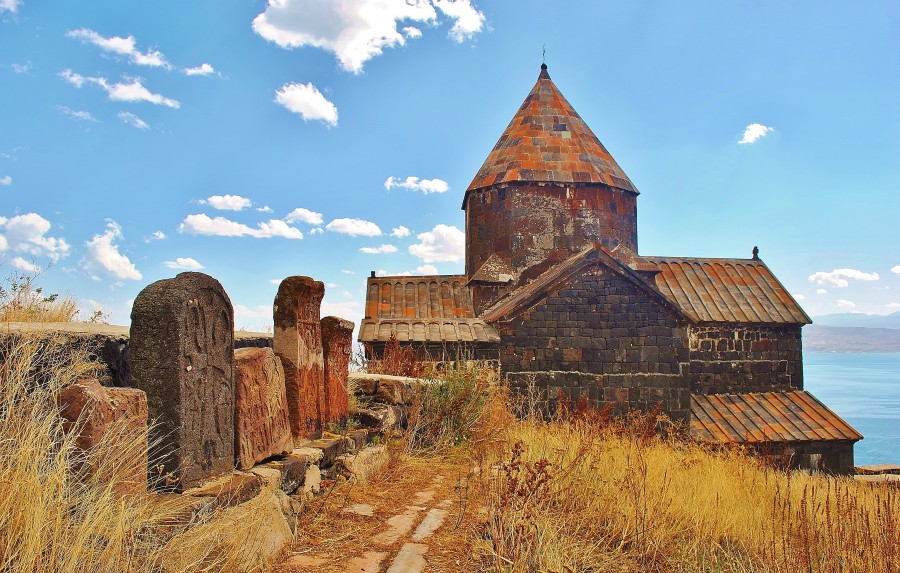
Sevanavank church on Sevan island. Armenia.
As far as I know, there is no organized transport from Eryu to the lake, so most of them get there by a shared taxi.
Transportation from Sevan to Erythra
After picking up my backpack I went along the road to the gas station and there after a few cups of tea I managed to find a hitch. This time I was driving a truck with two young men who asked me about my impressions of Armenia.
Yerevan (the capital of Armenia)
Yerevan is a cultural, political and economic center of Armenia, a city of beautiful architecture and interesting galleries and, on the other hand, a city of traffic and turbulent life. Erasing Center is an opera around which cultural life takes place. In the short distance there are parks, museums, numerous fountains, galleries under the open sky and an impressive building called Cascade. Yerevan is also a city of beautiful women walking around the city after the runway and presenting their charms which only adds to the light of this city. I sat in the museum part of the city repeatedly watching the fountain move to the rhythm of the music and then go through the artificial ponds and climbing among the sculptures to climb the cascade. In Yerevan I spent about 3 days and organized some interesting excursions.
My truck driver dropped me off in the suburb of Eryania and then standing at the bus stop the lovely girl told me to which bus to take to get to the opera. But then the girl was not so lovely because she gave me her phone number and a kiss for goodbye but she did not come to the meeting. Well … I got to the opera and went to the opera in the very center of the city in a post-Soviet block I made my room. I stayed at Sayat Nova for 5000 trains per bed, which is like the downtown area very cheaply. I was there only myself and an older lady who had walls full of pictures of head full of stories about Armenia.
Before I could change my shirt and finish my evening cup of tea, I went to see Yerevan at night. This time, two young women, whom I met earlier, saw me through the city. It was an evening when I met the city and did not take pictures. My friends showed me the opera, then we entered the nicely lit cascade and then through the shopping street we reached the museums where we sat listening to music and looking at the raging fountains. At the very end we went to a Georgian restaurant for tea or Georgian dumplings, which I ate without much commitment because I had them all the time in Georgia a couple of weeks earlier. We talked, we got some toasts and it was very nice. In the evening we said goodbye, and after some time I was lying on the grass on the pond and finally went to sleep.

Surp Grigor Lusavorich Cathedral built to celebrate 1700 years of Christianity in Armenia. Yerevan.
The next morning after tea, of course, and after talking with an older lady I went for a real tour. Yerevan has many interesting monuments and I chose the most interesting. Before this happened I first went to the Nagorno-Karabakh consulate number 62 and then went straight back to the opera. Opera is officially recognized as the city center and there are not only opera concerts there. Around there are interesting monuments on pedestals, parks and social life until late. Nearby is Cascade , which I mentioned before. It is a high floor building that can be accessed on high stairs. At the entrance there is a park where there are many interesting and also funny sculptures such as the statue of an oily woman and fat cat and a statue of a fat Roman man. There is, of course, a very carefully trimmed lawn leading to the Cascade. On each floor there are other types of fountains and original sculptures. Some of them are big heads coming out of the water, a water jumper in various phases of flight, a man with a spooky smile and my favorite; lion built with tires. On each floor there are many other sculptures and fountains and water sections in other shapes and in the evening the whole structure is still illuminated. Inside there are escalators and next sculptures on each floor, one of which is a huge orchid, although I guess that these sculptures are changing. At the bottom is a shop with glassware and they are objects from cow-shaped cups to true glasswork.
In my mind was also a very small park with a monument of four walking men and a gallery of paintings under the open sky. These are interesting works sold by the artist. Then once again passing through the Opera and its monuments I got to another park with the Swan Lake, a statue of an Armenian pianist made with great imagination and instruments constructed from artificial grass. Here is a good and yet reasonably priced place to dine what can not be said about the street shopping Mashtots Poghota . This is a street of more expensive restaurants and unfortunately American investment framed in colorful signboards that have nothing to do with Armenia.
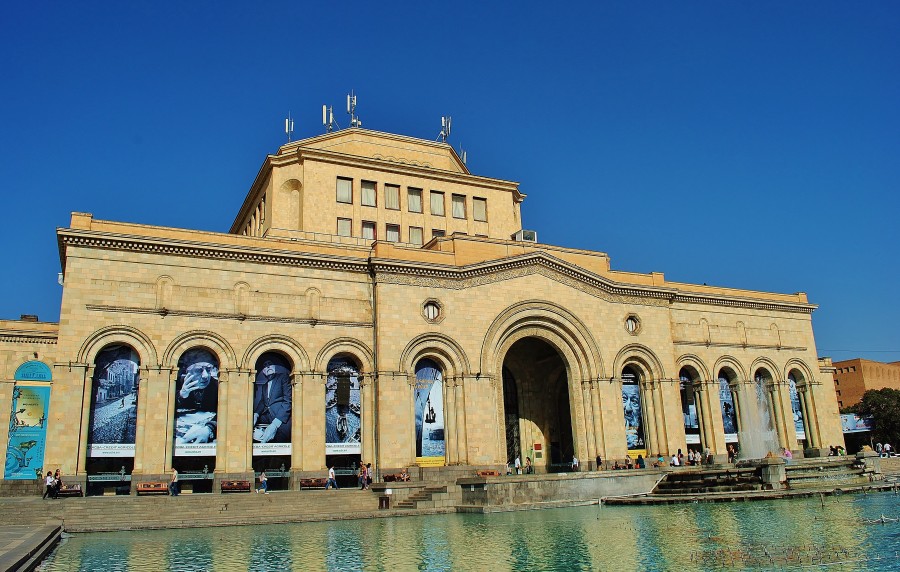
The National Gallery. Yerevan, Armenia.
After a while I got to the Republic Square (Hanrapetutyan Hraparak). This is probably the most effective square in Armenia. In the center there is a large fountain whose salves move to the rhythm of music, and there is also the National Gallery, the National Museum and also the Marriott hotel located in the historic building. It is a meeting place of the whole city and a tourist center, and you can spend your time just sitting and watching the fountain and listening to music. On the day it was all I saw but next I started right here. I went to the National Gallery and National Museum but I was not alone. I met a pretty Polish woman with whom I saw the whole art and that I wanted to save I entered the museum for a scuba diver card instead of student ID. The cashier did not know English yet and so did it. The gallery is very impressive, as there is a collection of Western and Russian painters in my room, as well as some lovely sculptures. The national museum tells the story of Armenia from the Greek times to the transition to Christianity, followed by Turkish, Persian and Arab invasions. In addition, there are costumes, coins, medieval hooks and jewelry.
Then, walking across the Republic Square, I turned left and on the crowded street I reached the merry-go-round and the monument of a horse-riding with a sword and the beautiful and grandly built Cathedral of Sourp Grigor Lusavorich . This beautiful cathedral was completed in 2001 on the occasion of the 1700th birth of Armenian Christianity. The next day, I first saw Matenadaran, a monumental library with 17,000 Armenian manuscripts and 100,000 medieval and new documents. In other words, especially given the terrible history of Armenia, Matenadaran is an important center of cultural history. There are several monuments to scholars and one of them is Mashtots. In my opinion, Matenadaran is very exquisitely built both on the outside and inside, but I think that the scientific interests accumulated here will not be of interest to someone who is not specialized in this field because of their misunderstanding. Anyhow the exposures are worth seeing.
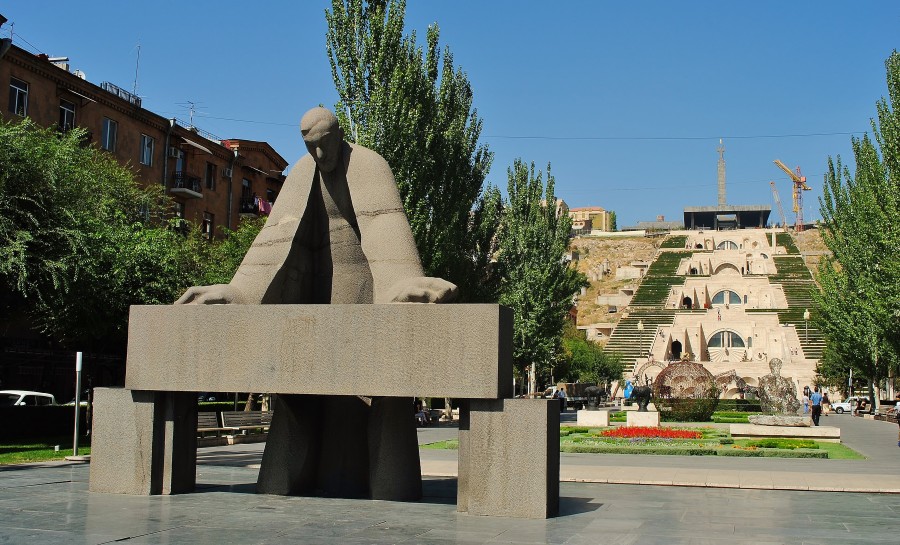
The famous Cascade in Yerevan, the capital of Armenia. In front of the Cascade there is a monument of architect Alexander Tamanian, who was the first to come up with the idea to build this object.
From here I took the old Ziguli and for about 1,000 drams I went outside the center of Eryan, to the Monument and Museum of Genocide Genocide Tsitsernakaberd . This is a tragic, tragic place about the crime committed by the Turks in the Armenians, which is only an indisputable proof of what Muslims are capable of as a final solution for Christians . Muslim Muslims brutally murdered about 1.5 million Christians massacring them in the streets, burning their homes, churches, destroying their cultural heritage, and massacre women. One of the many brutal methods used by the Ottomans was to sail out of the Armenian sea and then throw them overboard. The museum depicts shocking photographs and indisputable evidence of Christian unrest, which the Turkish government has been telling lies in a lie. Then I drove hitchhiking to the center on the way off at the Brandy factory . Today there is also a museum and it is an interesting place that the director organizes tours of the tasting facility.
Then I went to a pretty cathedral near the bridge and then went to the Blue Mosque , which symbolizes good relations with Iran. It is worth mentioning that this mosque was built in 1765 by a Persian governor and has a 24 meter minaret and a round inlaid onion covered with a blue mosaic. On the margins opposite is a well-stocked bazaar with souvenirs and art. It is easy to see it because of the golden, decorated with bas reliefs. When I walked around the opera house I went to dinner at one of the many well-serving pubs and then went on a trip to the Museum and the Fortress of Erebuni . Around 782 BC, a huge fortress was erected on the mountain in Yerevan, although today only the walls have been built. In the museum below there are interesting bas-reliefs and jewelry and art from that period. On the wall of the museum itself I also liked the bas-reliefs with the image of the ancient king and a few sculptures of animals. I returned to opera by taxi for 1,000 drama sharing the cost with a tourist from Japan.
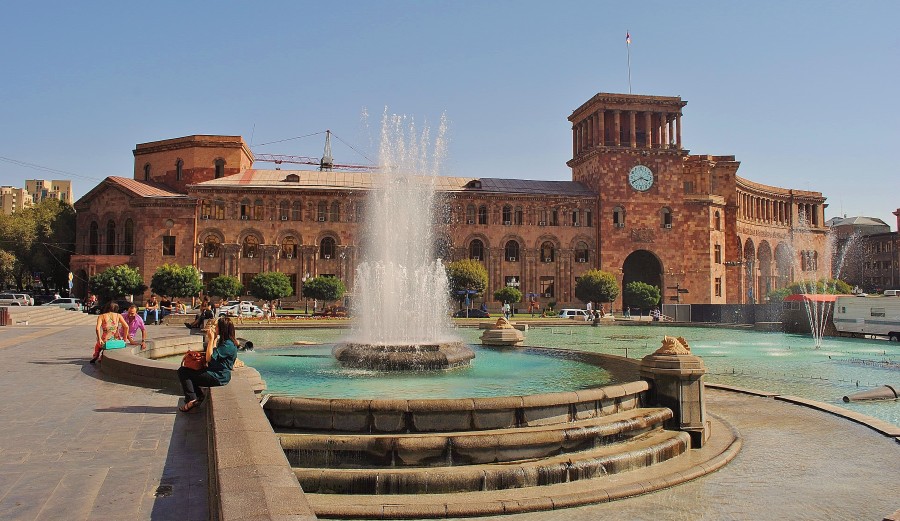
Republic Square. Yerevan, Armenia.
Around Yerevan
Trip to Etchmiadzin
Eszmiadzin is one of the greatest Christian attractions of the country and is sometimes also called the “Vatican of Armenia” although in my opinion and many other travelers it is also a big deal. In Eszmiadzin, there are many interesting churches and cathedrals that are a UNESCO world heritage, as well as the seat of the Armenian church and also the capital of Armenia in the years 180-340. One of the objects is the very proud name of the Catholic Palace. At first I went through the main gate to the area where was a huge green area and there were many churches usually surrounded by trees and flowers. To the left of the entrance there is a high, narrow chapel with an altar and a cross. Then there is a large green area and a large monument built in 2001 on the occasion of the arrival of Pope John Paul II and next to stands the Seminary Gevorgiana built in the nineteenth century.
Then I went straight until I saw the whole green area and the monument on the other side and I stopped at the place where there was a cemetery with old inscriptions on the gravestones. Behind it was the beautiful and historic Surp Gayane church built in the 7th century, although it was also restored in 1652. I was particularly impressed by the church because of its beautiful arches, hooks, and eagle-shaped reliefs. In the bright sunshine, Gayane has a dark orange color that falls into brown, has several towers and stone crosses on the tops and also small tombstones with ancient inscriptions. In addition, the Surp Gayane church also has some nice saint frescoes and a pretty altar. Gayane is located in a quiet corner behind the trees.

Surp Gayane Cathedral. Etchmiadzin, Armenia.
Then going back to the main gate I turned left to see the main church Mayr Tachar, which is one of the oldest churches in the world since it was built between 301-303 when Armenia was converted to Christianity. Since then, this cathedral has been rebuilt several times, in the 5th, 7th and 17th centuries. The building has one main tower and three smaller ones, and this is undoubtedly the most impressive church of all, and it is also surrounded by a nice garden and other buildings that have been built over the centuries. In addition to the bust of the temple complex Eshmiadzin there are three beautiful churches worth mentioning. The first is the Shoghakat Church built in 1694. It is small because it has one main bell and a small tower, it is built of red stone and is surrounded by a nice garden.
Another church is the Cathedral of the Most Holy Mother of God built in 1767, which is today the seat of the Diocese of the Armenian Apostolic Church. The last and also beautiful church is St. Hripsime built in 1618. This church is one of my favorites because it has not been changed at all and its beautiful, classic line has inspired many Armenian churches. Hripsime is built on elevation and just like the previous object it is built of red stone. At the bottom there is an orchard and a pleasant flower garden.
To Eszmiadzin I got a tape from Erynia for 1,500 drama and I came back hitchhiking and merry. Eszmiadzin is only 21km from Erythia and taxi ride takes about 15 minutes.

Echmiadzin, also known as the ‘Vatican of Armenia’, is home to a large temple complex.
Monastery Geghard and Garni
Geghard and Garni Monasteries are one of the biggest attractions in Armenia and are situated in beautiful natural surroundings. First I got to the Garni area by bus from Erywanie which took me about an hour and seemed to be eternity. From there I hired a driver of the old Moskvist, who for 9000 brought me 9km to Geghard and back to Garni. I will add that this price was exceptionally low because I have heard about sums like 3000 dram with one hour wait.
Geghard lies on the slope of a mountain in a picturesque canyon. There are also caves and rivers around and I think it is a great place to spend the day and night in the tent. The Geghard monastery itself consists of several buildings built of gray stone. Two main churches and two calabres were built in the 13th century.The chapels are carved in the rocks and inside there are prayer candles and sculptures including eagles and lions. In one of the chapels there is also a source of water which according to the beliefs has the properties of preservation of youth. My feeling about Geghard is very good. It is a complex of Christian caves and churches and the atmosphere in them is described as dark, mysterious and cool. I think Geghard is a very atmospheric object and my favorite part was the dark caves with candles in the center and the churches with their massive pillars, carved windows and arches. Geghard is built on several levels, which means that after entering the stone steps you can see churches, people, and canyons of many heights. In the churches there are also carved haczkary and reliefs of animals and mermaid patterns.
I think that given that Geghard was formed from the IV to the beginning of the 13th century and that of course due to the medieval period the whole was done in a very primitive way the work involved, even if the carving in the rocks was colossal. It is hard to imagine how huge the work was built pillars supporting the chapel is the ceiling of the cave, which is beautiful to this day.
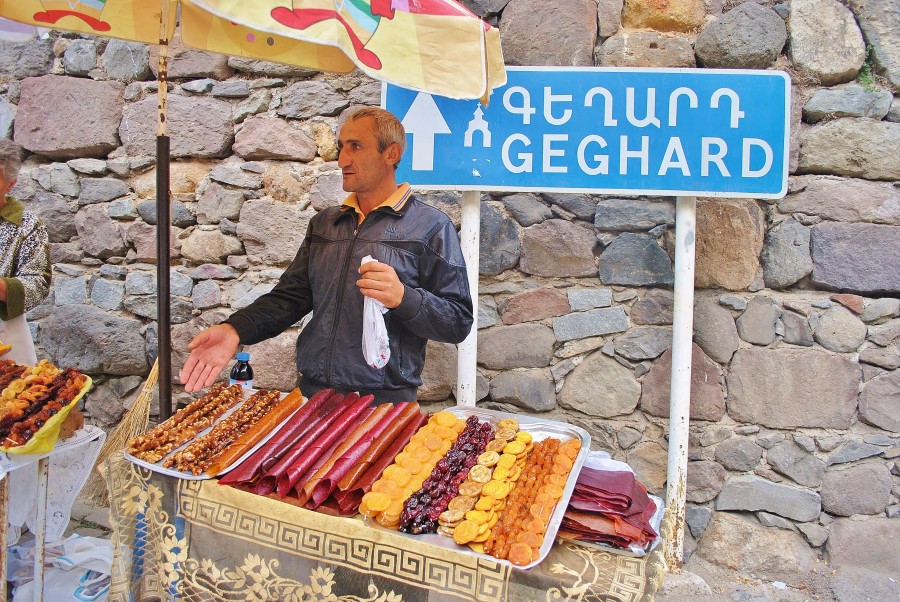
Healthy fruit and nut sweets, commonly known in Armenia as the ‘Armenian snickers’.
The second monastery, only 9km away from Geghard, is the pagan temple of Garni, and it is unique because it is completely different from all others. Garni was built in the 1st century by the King of Armenia Trdata I for Helios, the Roman god of the sun. This temple looks like the Greek Acropolis and the views from it encompass a large, picturesque canyon and the Azat River and, like Geghard, is also a very atmospheric temple. Apart from the beautiful mountain views, in addition to the pillars leading to the inside of the buildings and the scattered blocks of rocks, the background of the wind is also accompanied by music from the times when Garni was built.
Erywania I came back hitchhiking, that is once again I was lucky. Both temples definitely recommend and I think that you can make an interesting trip to the mountains with interesting temples as a sight to see.
Khor Virap
Khor Virap is another glorious monastery built on a rock that lies on the summit of Ararat, where Noah’s Ark was bogged down after 40 days of cruise. Khor Virap is also a temple that is very often seen on postcards, although I admit that to see the monastery against the background of snowy Ararat you have to have perfect weather in the high mountains, which happens very rarely. The foundation of Khor Virap began around the 5th century, but the entire complex was completed in the 17th century. Today it is a very popular direction of pilgrimage where many ceremonies such as baptisms and vows take place and its monastic fame owes its history to Christianity. Now Grigori Lusavorich, who later became a saint Grigore, was imprisoned here in the well by the pagan King Trdata III.
As I drove up to Khor Virap, I saw a mountain with a sidewalk on top of which stood a fortified church surrounded by walls. The main object is the Church of St. Mary of God (St. Astvatzatzin) which is not great. It only has one small bell and a tower, it is red and has rich decorations in it. In addition, I recommend a dark chapel where you can light candles. There are also metal stairs that lead through a narrow tunnel to where St. Gregory was once imprisoned. The Khor Virap temple is only 100m away from the Turkish border.
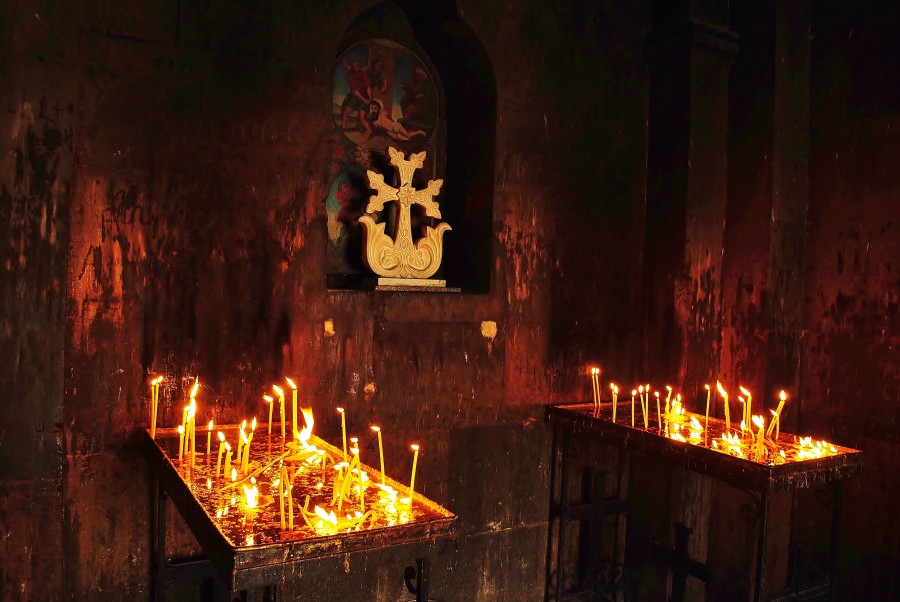
Cross and candles in the Khor Virap church. Armenia.
Khor Virap is located 30 km south of Erynai. I got a bus from Sasuntsi Davit Metro Station and after less than an hour I got off the road about 4km from the temple. First I went with my big backpack through the side road until I got to the main route. There I left a backpack in one of the stores and first walked and then grabbed a hitch. On the way back I started with travelers from Slovakia who took me to the main route.First I bought the grapes from the booth along the road and then waited on the road with my finger up. This time I did not return to Eryan, but I was heading south to Iran.
Ride from Khor Virap to the wilderness near Noravank
I waited some time on the route with my big backpack and after about half an hour finally stopped about 35 year old Ziguli with a rusty coat covered by paint. This time a man took me with his pregnant wife and two sisters. On the way we stopped many times at roadside stalls to buy fruit and vegetables, and there were plenty of them. We filled the trunk with a couple of bags of onions and potatoes, and we all had watermelons and crates under our legs. This transport gave me a picture of how people were buying food on the road and how the Armenian family was doing. Finally, after a few hours of driving, the driver drove me off the side of the road to the Noravank monastery at the Arena cave.
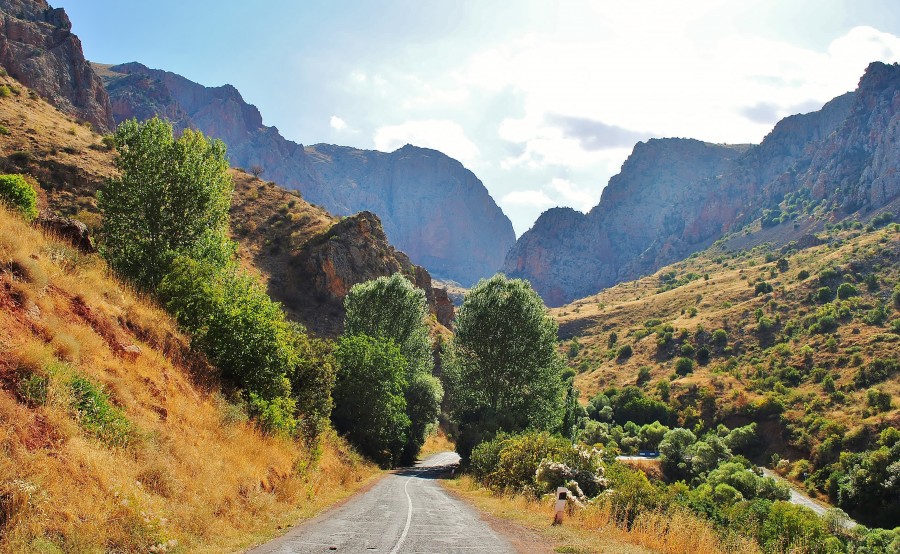
Picturesque mountain landscape of Armenia, near the Noravank church. Province of Vayots Dzor.
Vayots Dzor
Night in the tent, Areni cave and drive to the Noravank monastery
The driver of the red Zigula stopped at the fork of roads, shook my hand and said goodbye. This was another proof of the good character of the Armenian relative to the Pole who always helped me. At the crossroads it was also very nice because I was in the canyon cut by the rushing River Arpa. On one side there was an empty, overgrown field where I set up a tent and on the other side there was a restaurant where I invited myself for another fabulous dinner for only 1000 dramas. I was not idle, however, because over the restaurant, in the mountains of the red rock was the cave of the Arena. The cave of Areni, apart from geological wealth, was also interesting in terms of discoveries connected with people. Archaeologists believe that as early as 3900 BC people lived here and had the world’s first winery. Walking through the cave I saw lit tunnels and shattered pitchers and other everyday items that were in the cleaning phase.There are two entrances to the cave and the view offers beautiful views of the mountains, the river and also the route.
I spent the night in a tent on a hard earth and it was not nice but as I remember I managed to squint my eyes for a few hours. I woke up around 7 am because I was cold and went along the river to the truck parking. For a small money women made me breakfast for little money and tea was given as a gift. Then I went back to lodge the tent and I went down the canyon towards the Noravank monastery . Great adventure was my march because the views of red mountains, sometimes looking like thick rock slices of cheese stacked on top of each other and covered with green were very attractive. Also, the sun burned the canyon’s canyon, which added new colors as it was still very early. From the crossroads to Noravank is 8km which in such conditions is tiring but fortunately somebody took me and uphill uphill, under the gate monastery itself. Noravank was built in the 13th century and is a well-known monastery in Armenia due to its picturesque location in the middle of the canyon on the Darichay River.
Noravank monastery offers beautiful views of the red cliffs of the mountains and is one of the few bays of the temples. The main object is the church of S. Astvatsatsin adorned with beautiful bas-reliefs, one of which depicts the Father’s Boa.On the first floor you can reach the stone stairs around which are also made perfect in its details bas-reliefs. In the vicinity there are numerous fishing tackles and the Church of St.Grigor and St.Carapeta. The fence was built in the 17th and 18th centuries. It is also important to note that Noravank monastery is surrounded by many other caves besides Areni and is a perfect place for mountain hikes. In the main church on the ceiling I advise to look at the reflection of Jesus face on the stones.
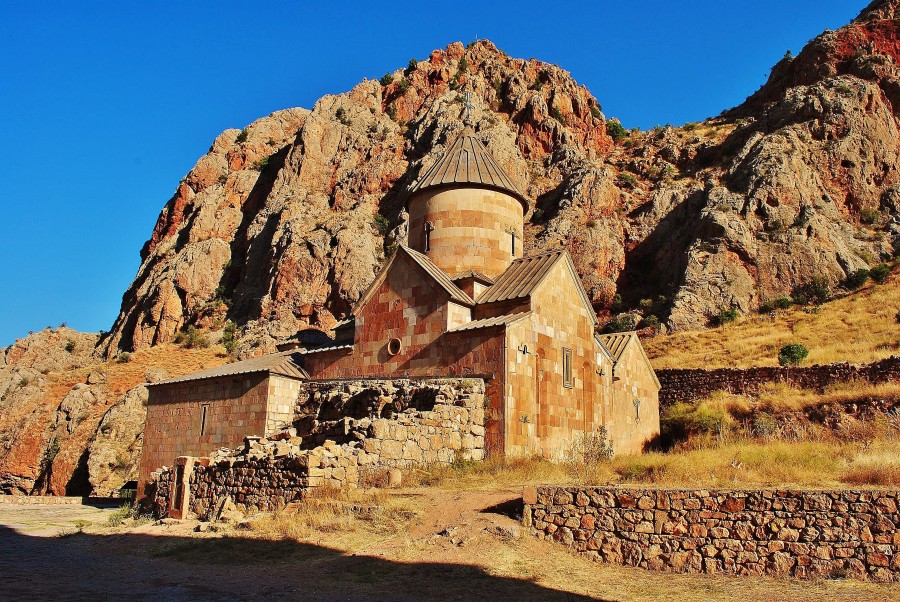
Noravank church. Vayots Dzor province, Armenia.
On the way back I first walked about half an hour enjoying magnificent views and then took me a coach with a group of Armenian tourists. I got off at the crossroads, picked up my backpack from the roadside bar and immediately got ready for the next action.
Hitchhiking from the exit onto Noravank via Yeghegnadzor to Artabuynk
Almost immediately I managed to catch a hitchhiking and after about 20 minutes I reached the suburbs of a small post-Soviet town of Yeghegnadzor . I went there to use the internet but I admit that Yeghegnadzor is not worth a visit. This is a gray town with concrete slabs where nothing interesting happens and there is nothing to watch. Then I went to the main road and came back hitchhiking 6km near Getap where the road to Yeghegis and Artabuynk is located. Unfortunately, it took me some time to hitchhike because it is a side road rarely frequented by cars. In the end, however, I was lucky because the Soviet truck stopped and it was a 25 year old Kamaz and that’s why I went in 25km further in style. The driver dumped me behind Yeghegis village in the village of Artabuynk.
Artabuynk, hard climbing and beautiful mountainous surroundings
This picturesque region of Armenia is in my opinion very much needed by tourists as a combination of rural life with mountain hikes. Yeghegis Valley is located 25km from the main road oasis of peace and quiet with beautiful rock formations and open spaces. You can break the tent and live a very adventurous life and you can also stay at the local family. The fortress of Smbataber and Tsakhatskar monastery are worth mentioning here.
I jumped out of the truck near the roadside shop where I left my backpack and immediately went on a trip.I walked the dusty road but after a while they brought me to the local. On the way I passed a turn to the fortress, but instead I went straight to where on the right was a green valley with a rocky peak. I was able to get off early and follow the simple route where my life would be much easier this day, but I felt that I needed more effort and adventure for the day. So I decided that I would climb up to about 50 meters up because this was closer but also difficult to compare. The first phase of entry was easy because the area was not too steep, and I could rest on the boulders and stick to the warmth of the trees. Moving up I stopped to photograph the green valley from different heights and some time my climb was quite bearable. The hardest point began when I stood under a vertical rock wall surrounded by dense, sharp trees and I had to figure out how to circle it and how to get through the scrub and vertical rocks to climb to the top. It was by far the most exhausting element of climbing because I was climbing up vertical rocks and slippery clay paths, holding branches of trees.
The first time I chose the most insecure route of all the uncertainty after I invested about half an hour of climbing appeared before me a wall which without the specialized equipment was impossible to travel. So I had to go down a bit and go the other way which fortunately gave the intended effect. Here it was not easy, but with the help of branches of trees and still boulders the road to the summit was to pass. Of course, standing on the top I was very happy because recently I looked at him from the bottom and I wondered how I can manage. I will advise future bolders that when you get into a huge vertical rock you have to break through the scrub on the left. The road to the right is only for those with equipment or for those who can fly. Then I went across the meadow on the plateau, and soon after, I saw an eternal monk Tsakhatskar, which consisted of several objects and many hacks.
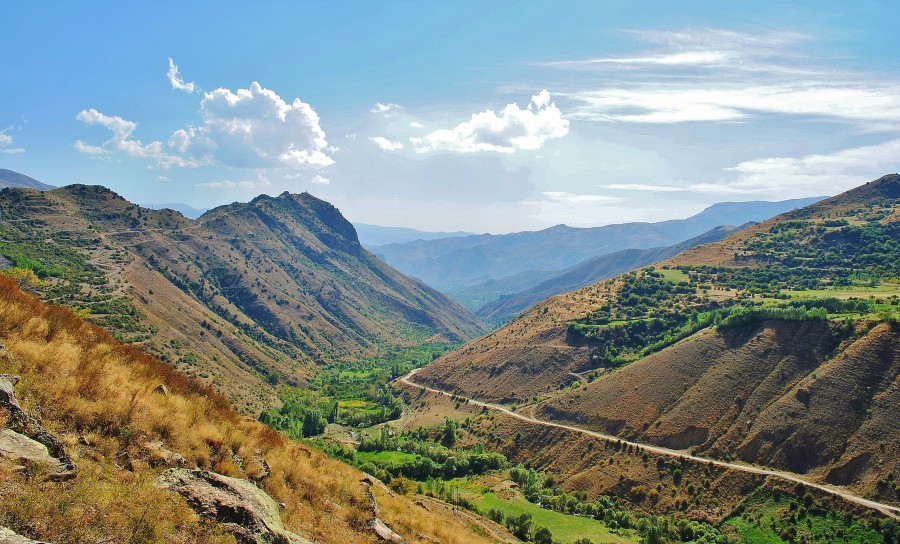
Picturesque mountain landscape of Armenia. Province of Vayots Dzor.
Walking from the cliff I first saw the ruins of the first church where only the ground floor with impressive arches and unfortunately with scattered stones around. Because of the boulders it is easy to overturn and turn your neck but I recommend to explore this remote, ancient place. Arches and cold, green boulders leading through the alleys of ancient history give a special sense of adventure. After passing another hundred meters through the clearing on the plateau I reached the best preserved church, with one bell, with interesting haczkarami and reliefs on the walls. One of them depicts a lion fighting a bull but I think the huge advantage of the Tsakhatskar monastery is the elaborately made haczkara on the church and also the silence, calmness and feeling of unmistakable loneliness. Around me was the picturesque Yeghegis Valley, while I was sitting at the bench and I was glad I could be here. I also add that the church can also replenish water supplies.
Then I walked down the valley until I reached the road where I was moving down.I could continue my journey on this trail as it is the easiest way to return to Artabuynk or to the Smbataberd fort. But I was looking for something more than just a walk through the dirt road, so I chose to cross the mountains to the fortress.It was not a good idea because, unfortunately, I had to descend down time and another time I had to climb over sharp rocks and it was an exhausting experience. After about an hour chase which easily can be called the extreme sport, and finally got to the deposited on the top of the fortress. Sharp rocks cut their shoes and I myself felt tired even though I am in good shape.
I got to the fortress Smbataberd. Fortress Smbataberd was built in the fifth century but was strongly fortified between armed and IX, and X and age was for the defense against the Turks and Mongols. Today, the fortress was no longer little but you can still see the main gate and walls and besides, it is a nice view of the valley Yeghegis. I am here I met an Armenian living in America, and his wife and a guide. I admit that I was very lucky because it was dark and gave me a lift to the store where I left a backpack. Then he invited me to myself that I still spent the night with them but I felt that the event will be alcohol, the more that the driver was drunk and drove to the trunk packed more beer and vodka. The host also invited me and I was with him because after the huge effort that day I wanted a quiet evening.It was a good choice because it was the Armenian family and after a meal and a short conversation and just went to sleep that night I fell asleep immediately.
The next day was even better because I spent the morning with them, I was walking in the orchard, I was by the river and I picked some grapes and apples. It was a very nice family with a great sense of humor and they joked with grandma. They said she looks like a witch and flies on a broomstick at night while showing me the broom and saying it is her vehicle. It was very funny and their home was a quiet place. Around 12 PM, the host of the house gave me a lift to the suburbs of Yeghegnadzor because he was going in that direction anyway.
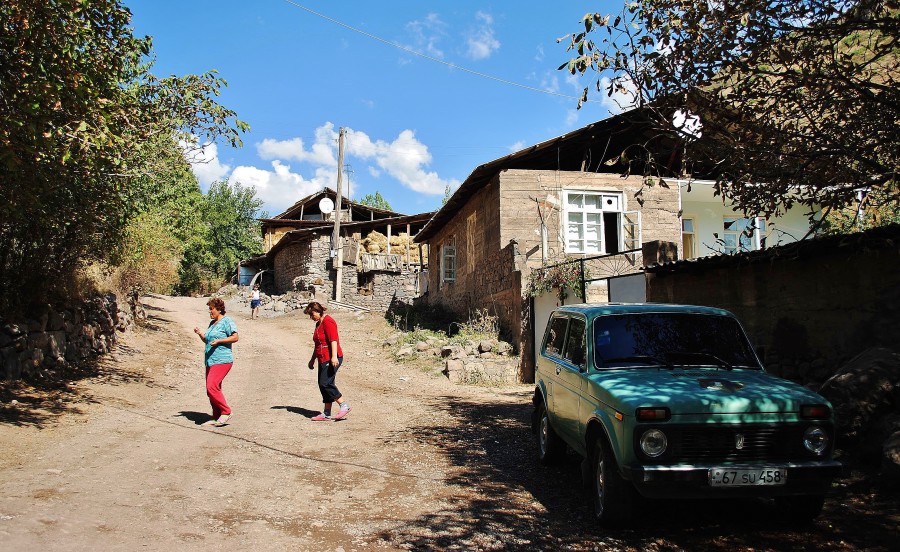
Armenian village.
Transport from Yeghegnadzor to Goris
My adventure in transport took almost all day and praise it yourself. I used many different hitchhiking, sometimes better sometimes tragic but in the end I got to where I wanted to.
His route began with a tour on the outskirts of Yeghegnadzor where at first I was waiting for any vehicle but nothing that I managed to catch szedłemkoło road. In the end, he stopped eaten by rust around 30 years old Soviet truck that picked me Vayk . Here drank tea in the shop and went further along the road. Soon zarzymał the Ormianin z Goris a pretty good car that drove me through southern Armenia. Weather spoilage but I had a good view of the mountains and vast clearings and then after entering the territory of the province of Syunik drove through the town of Sisian and my driver dropped me at a very interesting site called Zorats Karer. Zorats Karer having a sequence of about 3000 years stones arranged that the researchers have several uses. One of them are the graves of summer 3000 which means that the stones are funerary monuments, the second explanation is the function atronomiczna. Scientists are of the opinion that the people building this facility have a deep knowledge of the observation of stars, eclipses of the moon and the zodiac. Innymisłowy is the Armenian version of Stonehendge in England. Today it is a tourist destination for tourists and in my opinion very interesting, distant place that require more research. Zorats Karer is located 3.5km from Sisian and 400 meters from the main road in the field.
From Zorats Karer went from a group of french tourists to the main road, but first brought his backpack from the stone layer gdze before it hid.Standing on the main road I was not laughing because I was standing in the wilderness, it started to rain and the hours I could not stop any car. In the end, he stopped the van about 20 years old (the first time I saw such a car) which group of workers going to Goris. After traveling the near blew me 2km before Goris where I found the hotel.
I include this adventure to the next in the transport of their epic journey very low standard.
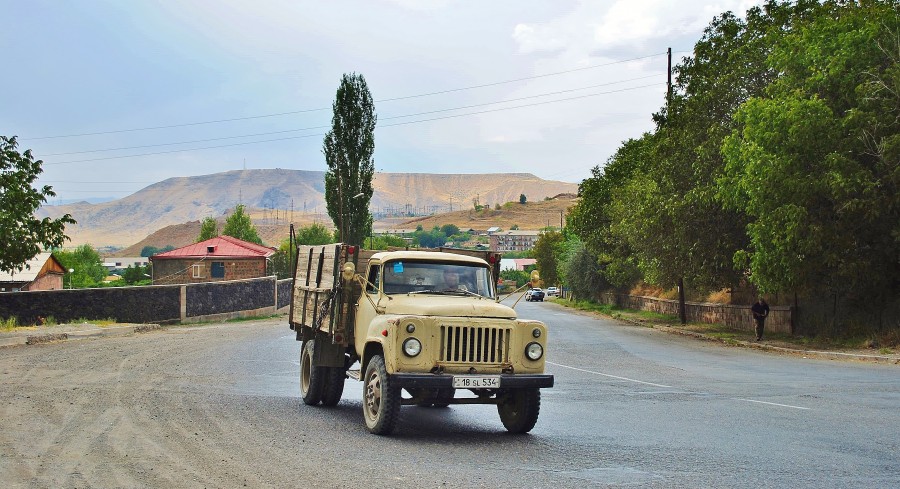
Transport in Armenia is a part of a beautiful adventure.
Syunik region
Goris
Goris is a small town nicely located in the valley. It is a quiet place where not much is happening and where among the few streets there are several pubs with kebabs and just outside of town with nice views and fruit trees. Goris was my base for over a week because in addition to the area it went from here to Tatev and the Nagorno-Karabakh and Goris also good fun. First, I lived in a good hotel outside the city for only 5,000 drams although the official price is 18000 and the return of Karabakh lived near the center of the store for 4000 drams. Goris has a lot of quiet streets where exploration has moved me to another world and also in the evenings playing music and sometimes where people danced. A lot of tourists is not here even for one night but I think that Goris is a necessity and should be in its surroundings to spend at least a few days.
The biggest attraction is the Old Goris , which is just behind the town of the mountains with carved cave dwellings. This place is often compared to the Turkish Cappadocia because as they were caves were created by man and in the fifth century served as residential houses. Also in Goris they have a conical shape and some rooms are connected together. In one of them I saw a bed and in many rocks there are also windows. Others are now used as shelters for cattle. My walk around the Old Goris was a very interesting adventure as I rode the mountains climbing the various heights of the caves and on the way I “grasped” a grape tree at one of the hosts. The people in Armenia are of course nice and the grapes were with their permission. In fact, they are here so much that they give it to tourists because they are not able to eat it themselves. Congested caves, grazing cows and slow-coming darkness gave a beautiful view. Panorama of Old Goris is unforgettable for me.
On the next day I went back to the mountains again and again, accompanied by scattered sheep, I went up to the caves and to the tops of the mountains. Then on the way back I helped the local chopping tree for which I got a cup of tea and some candy. I was a cheap labor force in Armenia but I did it with pleasure and it was a very good exercise. My room at Goris was one of the best so the more tired and soaked I was, the nicer it was to return to such conditions.
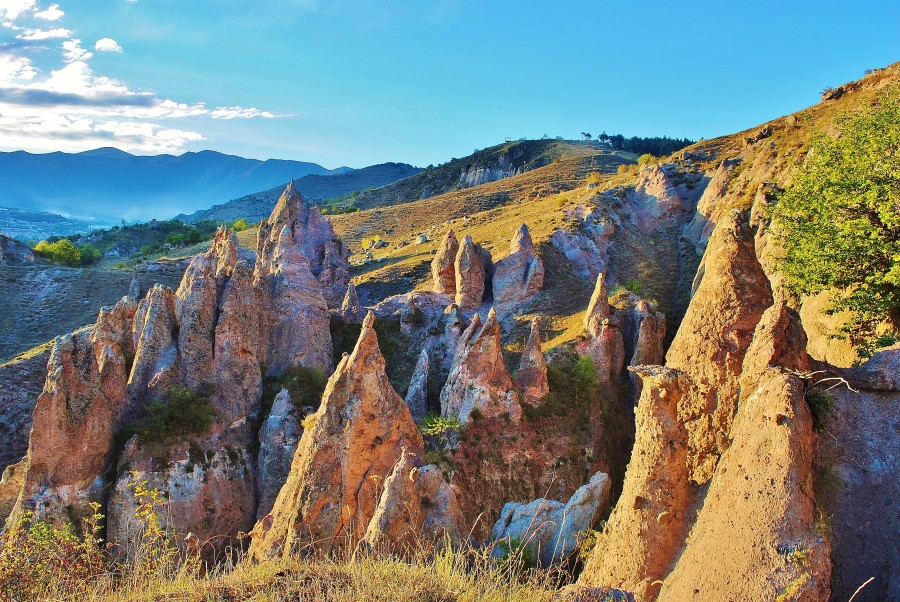
Old Goris are spectacular mountains with residential caves carved into them. Similar places are Damavand in Iran and Cappadocia in Turkey.
Expedition to Tatev
There is one tour that must be taken while in Goris and this tour is undoubtedly the strongest monastery on the cliff of Tatev. Tatev is a monastery built in the 9th century, which is today the biggest attraction of the province of Syunik, and in the late Middle Ages played an enormous role in the cultural and religious life of Armenia. Monastera Tatev lies on a 850m high cliff and is a fortified, naturally fortified church on the river Vorotan. The appearance is externally most impressive, though there is a beautiful church, fortified walls, a tower and numerous hacks and the medieval mill outside. Armenia does not suffer from the lack of antique monastry and Tatev is one of the most impressive. The story of Tatev is not entirely happy because the object was ransacked by Muslims.
Tatev is only 30km from Goris but it takes about an hour to get there on the winding mountain roads. I have stayed here twice because the first time was so thick fog that I did not see much. The first time I got here partly by hitchhiking and partly by foot and after the first hitchhiking and then I got to the mountain railway called “Tatev Wings”. In nice weather it is a strongly recommended form of transport because it easily reaches the monastery itself and there are beautiful views of the mountains and the village of Tatev. When I was going to Tatev the first time I was below the fog level, I stopped at the Devil’s Bridge . It is a natural bridge that formed after the break of the cliffs of Tatev and is a natural bridge to Tatev. Below the rock bridge there is a canyon leading to the lowest part of the Vorotan Gorge where even the sun rays do not reach. Fortunately, you do not have to descend down to about 800m to enjoy the natural beauty that we can observe just below the road. There are hot springs, waterfalls, and jars with impressive stalactites. This place is a break away from reality, but I advise to keep away from the edge of unprotected cliffs because nice corpses are not needed. Anyway, this magical, healing place attracts many tourists at any time of the year.
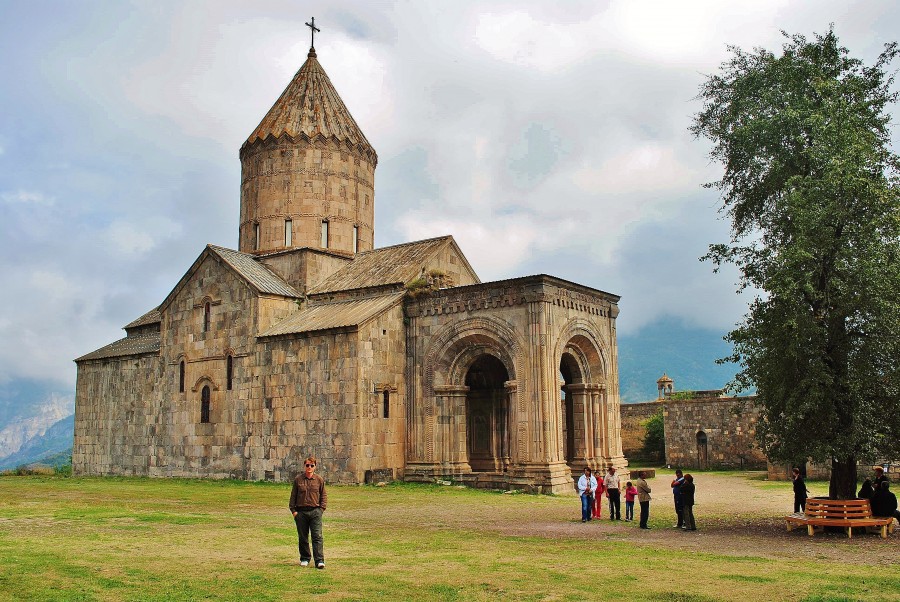
Tatev fortified church from the 9th century, situated in the mountains, on a cliff. Syunik Province, Armenia.
Transport from Goris to the border with Iran
Goris caught my first hitch. It was a group of young men riding an old Volga with which through winding wooded roads I drove 68km to Kapan . On the way we stopped for tea and talked about life in Armenia and Poland. Kapan is a small mining town, which flourished in the times of the Soviet Union, but today life is slow here and blocks of plates spoil the panorama of the mountains. However, there is a river and several quiet corners. Then some other hitches and among them old Żiguli and Łada Niva went another 33km to Kajaran, which is another small town lying among the picturesque mountains. Here I had a huge problem with transportation because the road to the south is rarely attended and it is a delicate area because of the border zone. So I went to the city and after about an hour of waiting I began to wonder where to put down the tent.
Finally however a bus ride that drove me through the mountains 50km to Meghri . Meghri is a nicer little town in the gorge and has some pretty churches and fortresses. Most tourists come here to get to Iran or to reach the very south of Armenia and see the Iranian village of Noordoz on the other side of the river. It is extremely important for tourists traveling to Iran to get money from the ATM at Meghri as Iran is a “cash only” country. From Meghri I took the route to Agarak (8km – 2000 dram) and then 2km further to the border with Iran. The border on Armenia was easy and those who pulled out dramas in Meghri reminded me to exchange money for dollars or euros in the cantor.
At the moment it was the end of my trip to Armenia and also to the Caucasus.
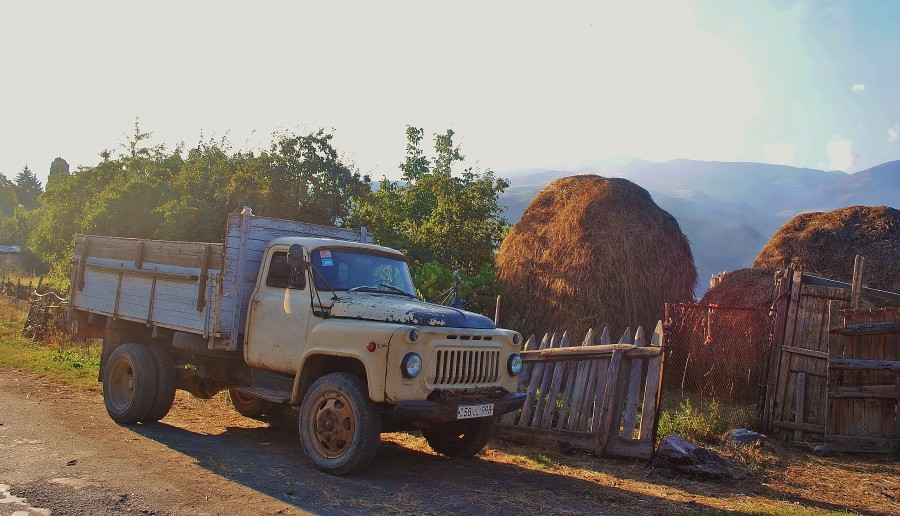
As part of the adventure, the Soviet Kamaz truck is gorgeous. What an experience!
The summary of Armenia
Armenia was a great adventure where every king of hitchhiking can be found in the mountains and reaching ancient churches. People are helpful and the skewers are very good. Besides the hotel’s own base, your own tent allows you to freely choose the place of temporary residence. Armenia is a country of beautiful outdoors and pretty women in the capital of Yerevan.



































